Main Parallelism Takeaways:
- Parallelism is a literary device that writers use to craft sentences or paragraphs with similar grammatical structures.
- This stylistic technique can enhance readability and add balance, flow, and rhythm to all writing types.
- Parallel construction is found in common expressions such as “easy come, easy go” and “a penny saved is a penny earned.“
- Reading aloud helps identify parallel structure.
- A parallel structure is essential when using coordinating or correlative conjunctions.
- Similar parts of speech or words with similar sounds may also be employed to create a parallel structure.
- Parallel construction that’s focused on oppositional relationships is known as an antithesis.
Whether you want to create an ear-pleasing political speech or a more readable piece of fiction, parallelism may be the technique you need. Learn more about this deliberate use of repetition in our handy guide to parallel structure in prose and poetry.
What is a Parallelism in Writing?
As a more specific answer to this question, parallelism, singular, cannot exist. The word itself implies repetition. Meanwhile, parallelisms, plural, are repeated similarities
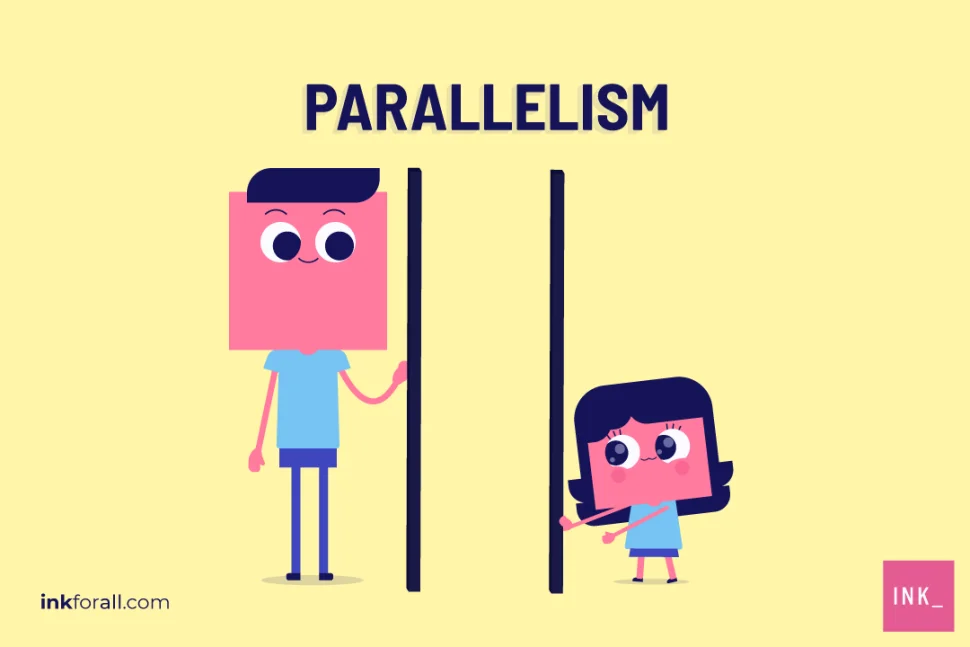

Going With the Flow Using Parallel Structure
Now that we know what it is, the better question may be what is a parallel structure used for and why it is useful. The answer is simple. Through parallel construction, you can add balance and flow to almost any type of writing, whether formal or informal. It can create a sense of rhythm, making prose (or poetry) pleasing to the eye and the ear.
Readability and Other Benefits of Parallel Structure
Another benefit of parallel construction is that it creates word patterns that are easy for a reader to follow. This can enhance readability and add authority to your writing. Thus, it is useful in writing speeches or other prose intended to be read aloud.
What is an Example of Parallelism?
Because the technique can be useful, parallelism is common. You’ll find parallel construction in everyday expressions such as “Easy come, easy go” and “Like father, like son.”
Other familiar examples of parallel structure include:
- “I came, I saw, I conquered.” (Julius Caesar)
- One small step for man, one giant leap for mankind.” (Neil Armstrong)
- What you see is what you get.
- A penny saved is a penny earned.
Martin Luther King Jr.’s iconic I Have a Dream speech is another fantastic example of an effective parallel structure. It could be the most well-known example of this technique out there.
Examples in Poetry
Parallel structure is an oft-used poetic as well, and examples abound in poems. One classic example is William Blake’s The Tyger, which employs repetition effectively, including book-ended first and final stanzas.
Furthermore, other parallelisms in The Tyger include repetition of the word “what,” repetition of questions, and repetition of certain vowel sounds.
For other poems that include examples of parallel structure, try reading:
- Annabel Lee by Edgar Allen Poe
- How Do I Love Thee by Elizabeth Barrett Browning
- The Lamb by Willam Blake
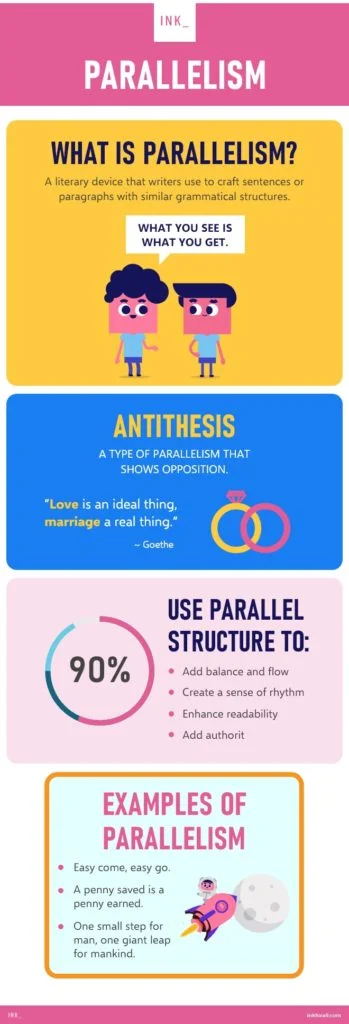

Parallel Structure: Stylistic Choice or Writing Essential?
That leads us to another question: Is parallel structure a stylistic choice or an essential grammatical tool?
Situations When Parallel Structure is Necessary
In the following grammatical situations, you should always use parallel structure.
With Coordinating Conjunctions
If you use coordinating conjunction such as and, but, or, for, and so to connect multiple phrases or clauses, use parallel structure.
With Correlative Conjunctions
If you’re linking two phrases or clauses with correlative conjunctions, such as if…then or either…or, use parallel structure.
With Comparison Words
If you’re joining two clauses with a comparison word, such as than or as, you should use parallel structure.
When Comparing Listed Items
When listing items, it’s essential to maintain parallel structure throughout the list.
Although parallel construction is essential to proper grammar in the examples above, the technique can be used to enhance style too. Fiction writers also use this literary device to build an atmosphere and to help create voice.
Creating Parallel Structure
Creating a parallel structure also involves repeating a chosen grammatical element within a sentence or paragraph. Each repeated element should contain a related topic or idea.
Essentially, repetition is your friend. But what does that mean when you put pen to paper?
Here are several easy ways to create a parallel structure in your writing.
Match Parts of Speech
If you’re comparing multiple items, whether in list form or through conjunctions, make sure each item adheres to the same grammatical structure. In other words, match the parts of speech.
If one item you’re comparing is a noun, then all items you’re comparing should be nouns. If one item is a present tense verb, all items should be present tense verbs.
You may notice that “watercolor painting” is still slightly different from “makeup” and “motorcycles” since it includes a descriptor. Since all the items in this comparison are nouns or noun phrases, this sentence is still parallel. The descriptor adds additional interest to the sentence.
Start Sentences with Similar Constructs
Parallel construction doesn’t solely exist within a sentence. It can occur in a paragraph (or even an entire short document). So, if you want to create emphasis and rhythm in a paragraph, consider starting several consecutive sentences with the same construct.
Although this technique can be useful to create rhythm and emphasis, it should be used sparingly. In general, good writing means varying the construction of sentence beginnings as well as their overall length.
Keep Topics Related
As the old saying goes, don’t compare apples to oranges (even though yes, they’re both fruit). In other words, create a parallel structure by sticking to topics that are related in some way. They may belong to the same class of items, reference related ideas, or explore similar themes.
Flip The Script
Oppositional relationships may include pairs such as:
- love/hate
- like/dislike
- is/isn’t
- will/won’t
Although these are oppositional thoughts, the construct is still similar (love when parallels hate when), forming an effective parallel structure.
Use Sound to Create Parallel Structure
Sound and meter can be useful tools when creating a parallel structure. Choose words with similar consonant or vowel sounds to explore a different aspect of this technique.
Meter—Not Only For Poetry
One way to create or enhance parallel construction between or within sentences is to match the meter. Meter is defined as the rhythmic structure of a line. It consists of the number of syllables in a line, combined with the emphasis on those syllables.
Although the meter is traditionally associated with poetry, it can also be used effectively in prose. You can incorporate meter into your parallel constructs by including phrases or sentences with identical syllable counts and a similar emphasis.
Notice how these two sentences not only have the same syllable count, but also similar emphasis on those syllables when read aloud.
How do you Identify Parallelism?
There are several simple ways to identify parallel structure in any piece of writing. Since it’s typically used in comparisons, look for similarities in structure, sound, and topics. Reading aloud can also help reveal patterns in meter, emphasis, and sound.
In identifying parallel structure, it may also be helpful to look for:
- Lists
- Conjunctions such asbut, and, for, and so
- Comparison words such as than and as
- Sentences or paragraphs with similar beginnings or lengths
- Opposites
But what happens when you find parallelism and it’s faulty?
Faulty Parallelism
Unfortunately, the parallel structure is easy to get wrong. Fortunately, when it goes wrong, it’s easy to troubleshoot and fix.
Troubleshooting Parallel Structure Issues
If you aren’t sure you’ve effectively created a parallel structure, you can troubleshoot it by creating a list of bullet points. Begin by writing out the section of your sentence that the bullet points pertain to. Then, each bullet point should represent one item or phrase in your sentence.
A Deeper Dive
Let’s look at an example.
Your list would then look like this:
The new cash registers…
- ensure accuracy
- speed up transactions
- better records
It’s easy to see where the sentence has gone wrong. Whereas “promote accuracy” and “speed up transactions” both start with verbs, “better records” starts with an adjective. It’s not parallel at all.
Making the Correction
You can rewrite the sentence to be parallel by amending the phrase “better records,” to begin with, a verb, matching the other two phrases. Let’s give it a try.
Your bulleted list would now look like this:
The new cash registers…
- ensure accuracy
- speed up transactions
- promote better record-keeping
The list now reflects an effective parallel structure since all three items begin with a verb.
Choices, Choices, Choices
Sometimes, there’s more than one way to fix a faulty parallel structure. Take this example.
In this example (and in most faulty parallel structures), there are two ways to correct the error. You just need to make sure all components match up.
What’s the Difference Between Parallelism and Repetition
Parallelism and repetition are both stylistic devices used in writing. Some writers view these two as the same, but they are not. In fact, there’s a distinct difference between parallelism and repetition — their area of focus.
Parallelism focuses on syntax, whereas repetition focuses more on semantics. See below examples:
As the name suggests, repetition involves repeating the same word, phrase, or sentence in writing. It’s commonly used in poetry and oratorical speeches to add emphasis or make statements more powerful.
Meanwhile, parallelism uses components that are grammatically the same, or phrases that are similar in meaning, sound, or construction. You can create parallelism by using other devices like repetition, epistrophe, or antithesis, to name a few.
Parallelism’s primary goal is to join similar concepts or place opposing ideas side by side to emphasize their differences.
This, That, and the Other Thing: Final Words on Parallelism
Whether you’re writing a novel, poem, or thesis, parallelism is an excellent tool for adding balance, creating rhythm, and effectively conveying your message. By learning this simple stylistic technique, you can make your writing more readable and appealing, no matter what your ultimate objective is.
Quick Parallelism Grammar Quiz
Parallelism Question #1
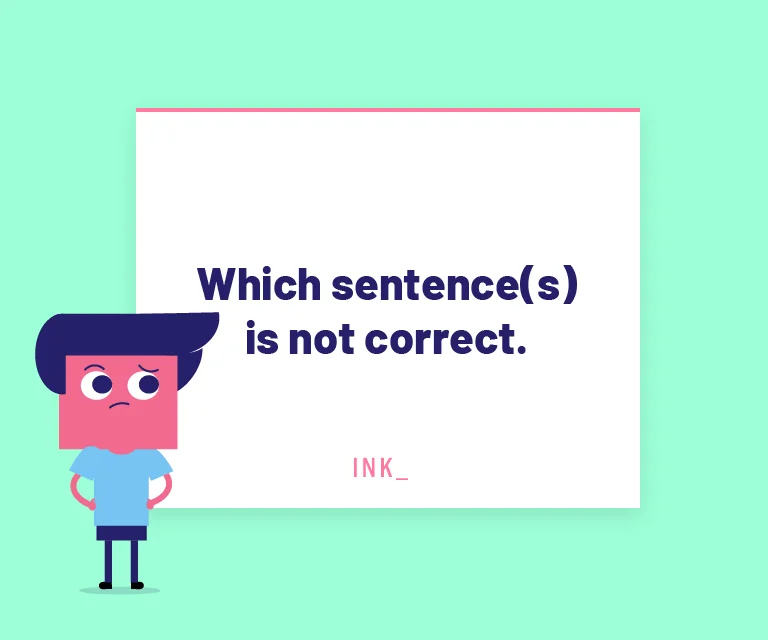

The answer is D. Parallel structures create a word pattern that's easy to read.
Parallel Structure Question #2
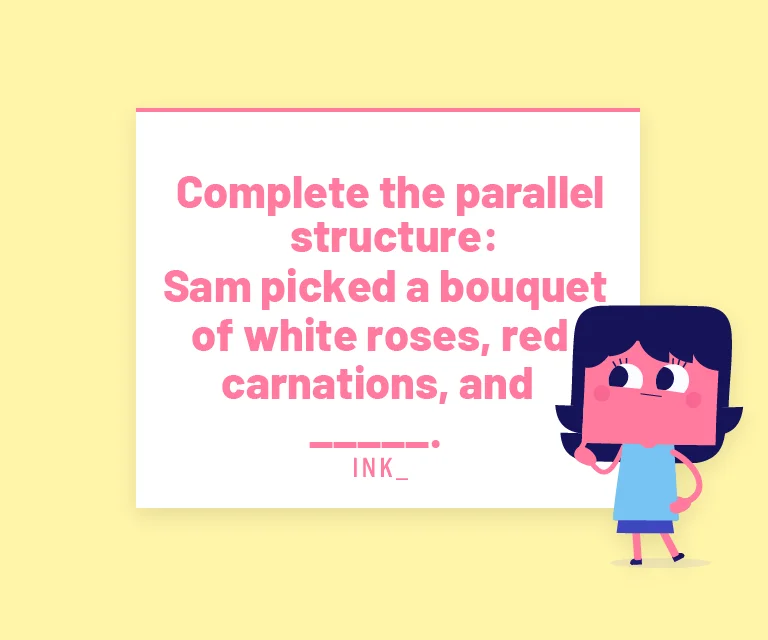

The answer is B. One way to use a parallel structure is to compare a list of items.
Parallelism Question #3
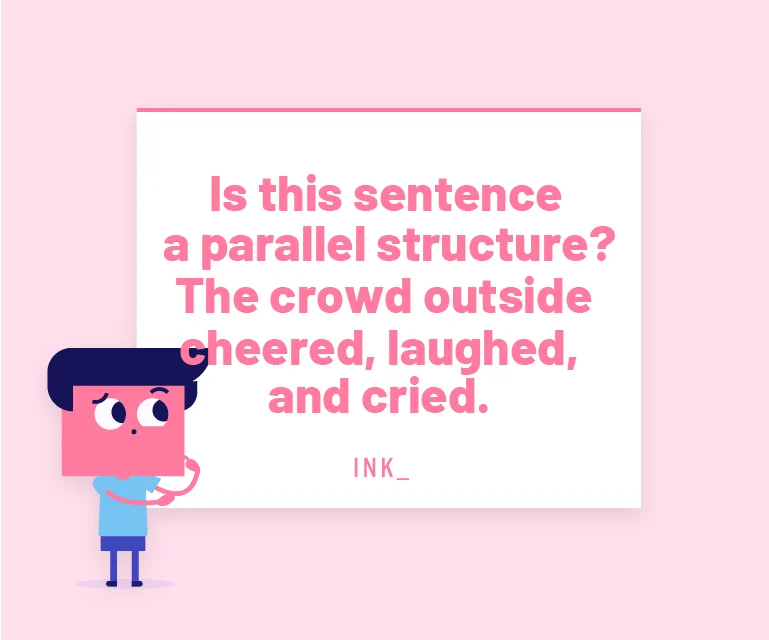

The answer is YES. Comparing a list of items is one way to use parallel construction.
Parallel Structure Question #4
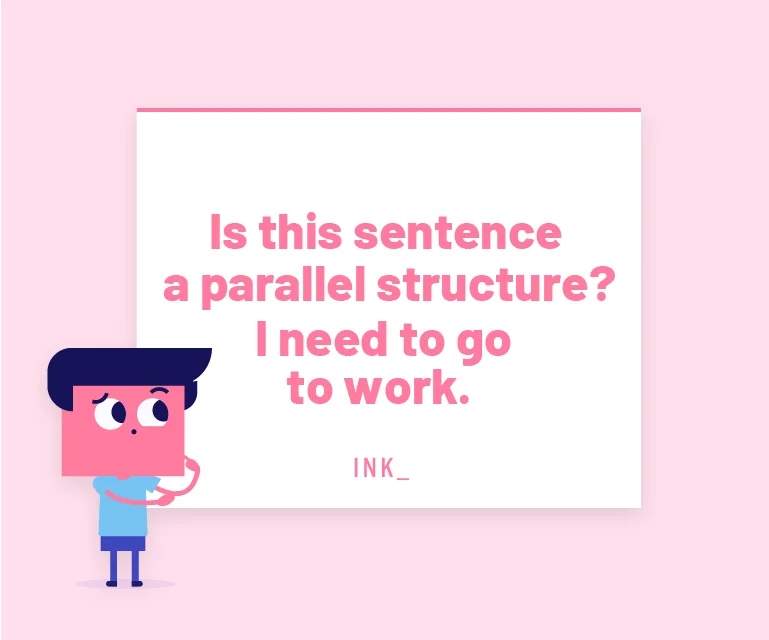

The answer is NO. The sentence lacks similar grammatical structures necessary to create a pattern.
Parallelism Question #5
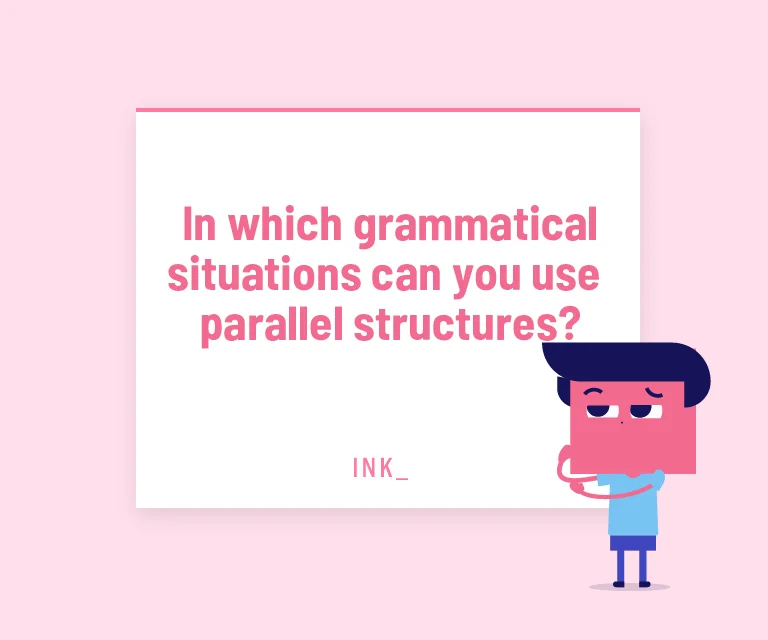

The answer is D. You can use parallel structure in all of these grammatical situations.
Parallelism Question #6
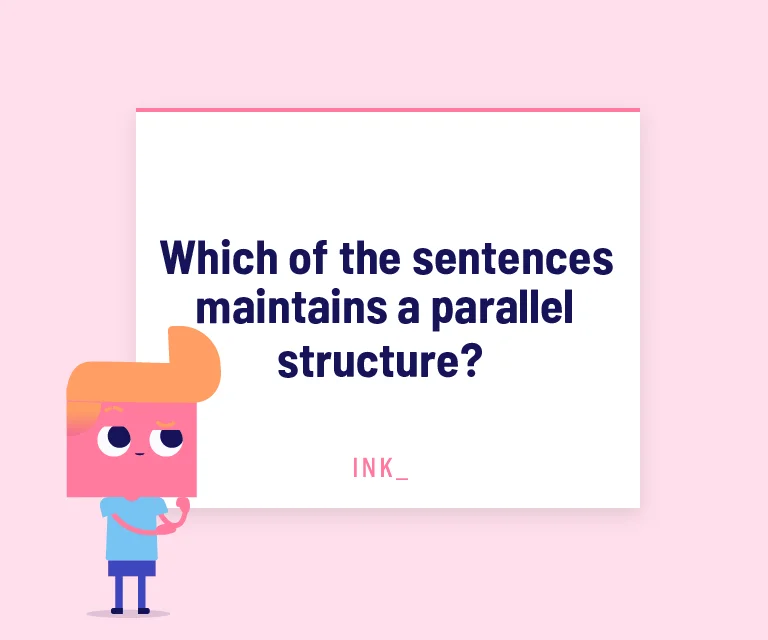

The answer is B. One way to use a parallel structure is to compare a list of items.
